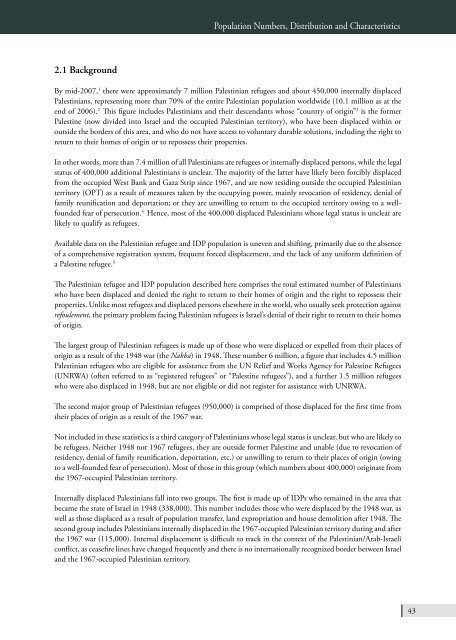BADIL Resource Center for Palestinian Residency and Refugee
BADIL Resource Center for Palestinian Residency and Refugee
BADIL Resource Center for Palestinian Residency and Refugee
Create successful ePaper yourself
Turn your PDF publications into a flip-book with our unique Google optimized e-Paper software.
2.1 Background<br />
Population Numbers, Distribution <strong>and</strong> Characteristics<br />
By mid-2007, 1 there were approximately 7 million <strong>Palestinian</strong> refugees <strong>and</strong> about 450,000 internally displaced<br />
<strong>Palestinian</strong>s, representing more than 70% of the entire <strong>Palestinian</strong> population worldwide (10.1 million as at the<br />
end of 2006). 2 This figure includes <strong>Palestinian</strong>s <strong>and</strong> their descendants whose “country of origin” 3 is the <strong>for</strong>mer<br />
Palestine (now divided into Israel <strong>and</strong> the occupied <strong>Palestinian</strong> territory), who have been displaced within or<br />
outside the borders of this area, <strong>and</strong> who do not have access to voluntary durable solutions, including the right to<br />
return to their homes of origin or to repossess their properties.<br />
In other words, more than 7.4 million of all <strong>Palestinian</strong>s are refugees or internally displaced persons, while the legal<br />
status of 400,000 additional <strong>Palestinian</strong>s is unclear. The majority of the latter have likely been <strong>for</strong>cibly displaced<br />
from the occupied West Bank <strong>and</strong> Gaza Strip since 1967, <strong>and</strong> are now residing outside the occupied <strong>Palestinian</strong><br />
territory (OPT) as a result of measures taken by the occupying power, mainly revocation of residency, denial of<br />
family reunification <strong>and</strong> deportation; or they are unwilling to return to the occupied territory owing to a wellfounded<br />
fear of persecution. 4 Hence, most of the 400,000 displaced <strong>Palestinian</strong>s whose legal status is unclear are<br />
likely to qualify as refugees.<br />
Available data on the <strong>Palestinian</strong> refugee <strong>and</strong> IDP population is uneven <strong>and</strong> shifting, primarily due to the absence<br />
of a comprehensive registration system, frequent <strong>for</strong>ced displacement, <strong>and</strong> the lack of any uni<strong>for</strong>m definition of<br />
a Palestine refugee. 5<br />
The <strong>Palestinian</strong> refugee <strong>and</strong> IDP population described here comprises the total estimated number of <strong>Palestinian</strong>s<br />
who have been displaced <strong>and</strong> denied the right to return to their homes of origin <strong>and</strong> the right to repossess their<br />
properties. Unlike most refugees <strong>and</strong> displaced persons elsewhere in the world, who usually seek protection against<br />
refoulement, the primary problem facing <strong>Palestinian</strong> refugees is Israel’s denial of their right to return to their homes<br />
of origin.<br />
The largest group of <strong>Palestinian</strong> refugees is made up of those who were displaced or expelled from their places of<br />
origin as a result of the 1948 war (the Nakba) in 1948. These number 6 million, a figure that includes 4.5 million<br />
<strong>Palestinian</strong> refugees who are eligible <strong>for</strong> assistance from the UN Relief <strong>and</strong> Works Agency <strong>for</strong> Palestine <strong>Refugee</strong>s<br />
(UNRWA) (often referred to as “registered refugees” or “Palestine refugees”), <strong>and</strong> a further 1.5 million refugees<br />
who were also displaced in 1948, but are not eligible or did not register <strong>for</strong> assistance with UNRWA.<br />
The second major group of <strong>Palestinian</strong> refugees (950,000) is comprised of those displaced <strong>for</strong> the first time from<br />
their places of origin as a result of the 1967 war.<br />
Not included in these statistics is a third category of <strong>Palestinian</strong>s whose legal status is unclear, but who are likely to<br />
be refugees. Neither 1948 nor 1967 refugees, they are outside <strong>for</strong>mer Palestine <strong>and</strong> unable (due to revocation of<br />
residency, denial of family reunification, deportation, etc.) or unwilling to return to their places of origin (owing<br />
to a well-founded fear of persecution). Most of those in this group (which numbers about 400,000) originate from<br />
the 1967-occupied <strong>Palestinian</strong> territory.<br />
Internally displaced <strong>Palestinian</strong>s fall into two groups. The first is made up of IDPs who remained in the area that<br />
became the state of Israel in 1948 (338,000). This number includes those who were displaced by the 1948 war, as<br />
well as those displaced as a result of population transfer, l<strong>and</strong> expropriation <strong>and</strong> house demolition after 1948. The<br />
second group includes <strong>Palestinian</strong>s internally displaced in the 1967-occupied <strong>Palestinian</strong> territory during <strong>and</strong> after<br />
the 1967 war (115,000). Internal displacement is difficult to track in the context of the <strong>Palestinian</strong>/Arab-Israeli<br />
conflict, as ceasefire lines have changed frequently <strong>and</strong> there is no internationally recognized border between Israel<br />
<strong>and</strong> the 1967-occupied <strong>Palestinian</strong> territory.<br />
43

















